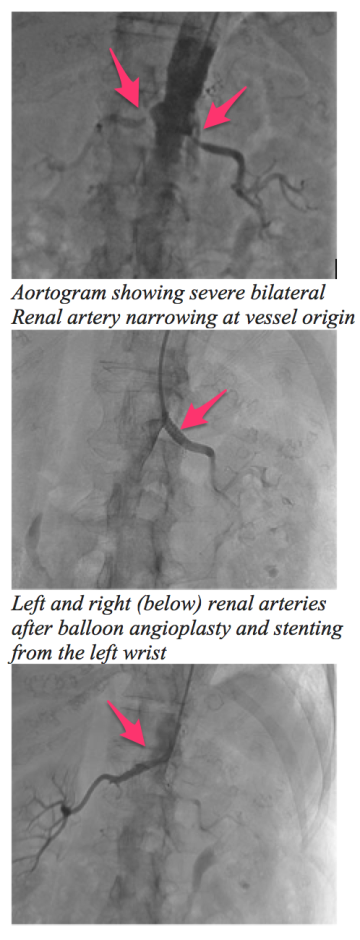Peripheral Vascular Disease
Find your care
Interventional cardiology teams provide care in multiple locations. To learn more about our services, call 310-825-9011.
Peripheral arterial disease is common, affecting over 3 million people a year in the United States. Cholesterol plaque deposition can be a systemic problem in the body, affecting not just the heart but also arteries in the legs, kidneys (renal arteries), arms and neck (carotid arteries).
Depending on the location, symptoms may range from dizziness, gait instability and arm pain (subclavian arteries), high blood pressure that is difficult to treat or sudden episodes of difficulty breathing (renal arteries), or calf pain with walking and/or leg ulcers (femoral and popliteal arteries).

Those at highest risk for such symptoms are also at high risk for heart disease, such as those who smoke or have diabetes. As such, preventive measures for both peripheral and cardiac disease are similar and include optimization of blood pressure, cholesterol, dietary modification and in increase in physical activity as tolerated.
Our team of specialists includes experts in both heart and vascular disease, who are able to detect and treat abnormalities in the entire circulation system. These specialists are board certified in cardiology, interventional cardiology, vascular imaging and endovascular (minimally invasive) intervention.
Our team of specialists includes experts in both heart and vascular disease, who are able to detect and treat abnormalities in the entire circulation system. These specialists are board certified in cardiology, interventional cardiology, vascular imaging and endovascular (minimally invasive) intervention.
Our team of specialists includes experts in both heart and vascular disease, who are able to detect and treat abnormalities in the entire circulation system. These specialists are board certified in cardiology, interventional cardiology, vascular imaging and endovascular (minimally invasive) intervention.
Diagnostic Testing and Goals of Treatment
To accurately diagnose abnormalities in the cardiac and vascular systems, our specialists rely on tests that may be conveniently performed during a regular office visit and include ankle brachial index (ABI), arterial and venous ultrasound and treadmill exercise tests.
Our cardiac and vascular intervention specialists offers a comprehensive, cutting-edge approach to the evaluation and care of patients with peripheral arterial disease utilizing a minimally invasive endovascular approach.
We collaborate with other specialists in treating certain patients, such as interventional vascular radiologists and vascular surgeons. Our treatment goals are to provide symptom relief and improve quality of life while simultaneously emphasizing prevention of future vascular problems. We do so by providing guidance regarding exercise therapy, smoking cessation and medication optimization. When feasible, a conservative first approach is utilized, wherein a procedure is performed only if necessary.
At UCLA, we have the ability to coordinate care with world class interventional radiologists and vascular surgeons if a multidisciplinary approach to treatment is indicated. All of our vascular specialists are board certified in cardiology and interventional cardiology will be able to guide treatment of associated cardiac conditions if necessary.
Areas of Expertise
Blocked arteries may be treated with balloon angioplasty, and if needed, metal alloy scaffolds or stents. Similar to techniques used in heart (coronary) arteries, angioplasty involves the advancement of a balloon tipped catheter over a wire rail to the site of blockage. The balloon is then inflated for some time, deflated and removed, thus relieving the occlusion. Such relief tends to last for several months after which the artery may re-narrow. Drug coated balloons prevent arterial re-narrowing, by coating the inner lining of the artery with a medication that inhibits formation of plaque. They are sometimes used in combination with atherectomy – a procedure wherein plaque is removed from the vessel with various tools including lasers and high speed rotating burrs.
Stents are metal alloy scaffolds utilized when balloon angioplasty alone is deemed inadequate, and based on the location, may be flexible, rigid, covered or drug coated.
Our experienced operators can relieve blockages in the arteries that are completely blocked, particularly blockages that have been present for months and sometimes for years called chronic total occlusion. Such blockages are sometimes associated with non-healing leg wounds or ulcers, which in dire cases may threaten limb viability.
An ultrasound catheter can be threaded through the clogged artery to determine the severity and location of a given blockage, and can be very helpful in determining sizing of balloons and stents, as well as understanding mechanisms of re-narrowing.
Clinical Trials
Your physicians at UCLA Health are committed to providing cutting edge care backed by novel devices and ongoing clinical research. We are currently participating in trials investigating various aspects of cardiovascular disease.